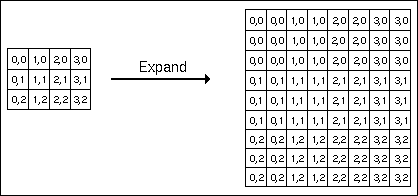IMAQ Expand VI
Owning Palette: Image ManipulationInstalled With: NI Vision Development ModuleExpands (duplicates) an image or part of an image by adjusting the horizontal and vertical resolution.






 |
Optional Rectangle defines a four-element array that contains the left, top, right, and bottom coordinates of the region to process. The VI applies the operation to the entire image if Optional Rectangle is empty or not connected. |
||||||
 |
Image Src is a reference to the source image. |
||||||
 |
Image Dst is a reference to the destination image. |
||||||
 |
X Duplication Step specifies the number of pixel duplications per column. The column is recopied if the default value (1) is used. |
||||||
 |
error in (no error) describes the error status before this VI or function runs. The default is no error. If an error occurred before this VI or function runs, the VI or function passes the error in value to error out. This VI or function runs normally only if no error occurred before this VI or function runs. If an error occurs while this VI or function runs, it runs normally and sets its own error status in error out. Use the Simple Error Handler or General Error Handler VIs to display the description of the error code. Use error in and error out to check errors and to specify execution order by wiring error out from one node to error in of the next node.
|
||||||
 |
Y Duplication Step specifies the number of pixel duplications per line. The row is recopied if the default value (1) is used. |
||||||
 |
Image Dst Out is a reference to the destination image. If Image Dst is connected, Image Dst Out is the same as Image Dst. Otherwise, Image Dst Out refers to the image referenced by Image Src. |
||||||
 |
error out contains error information. If error in indicates that an error occurred before this VI or function ran, error out contains the same error information. Otherwise, it describes the error status that this VI or function produces. Right-click the error out indicator on the front panel and select Explain Error from the shortcut menu for more information about the error.
|
Details
For example, if a 256 × 256 image is connected and the X Duplication Step and Y Duplication Step are both equal to 2, the resulting image has a resolution of 512 × 512. Each pixel in the original image now is represented by four pixels (2 × 2) in the new image.
The following figure illustrates an expansion of an image where X Duplication Step equals 2 and Y Duplication Step equals 3.





